The aroma of sautéing onions and celery fills the kitchen, instantly transporting me back to childhood family gatherings. This Homemade Stuffing recipe is a delightful twist on a classic that transforms simple ingredients into a comforting side dish. Perfect for holiday feasts or any cozy dinner, this stuffing not only offers a quick prep time but also guarantees to be a crowd-pleaser at your table. With its rich flavors from fresh herbs and buttery goodness, making stuffing from scratch can elevate your meals beyond fast food convenience. Don't you just love the warmth of homemade dishes that bring people together? Let's dive into creating this delicious stuffing that will have everyone asking for seconds!
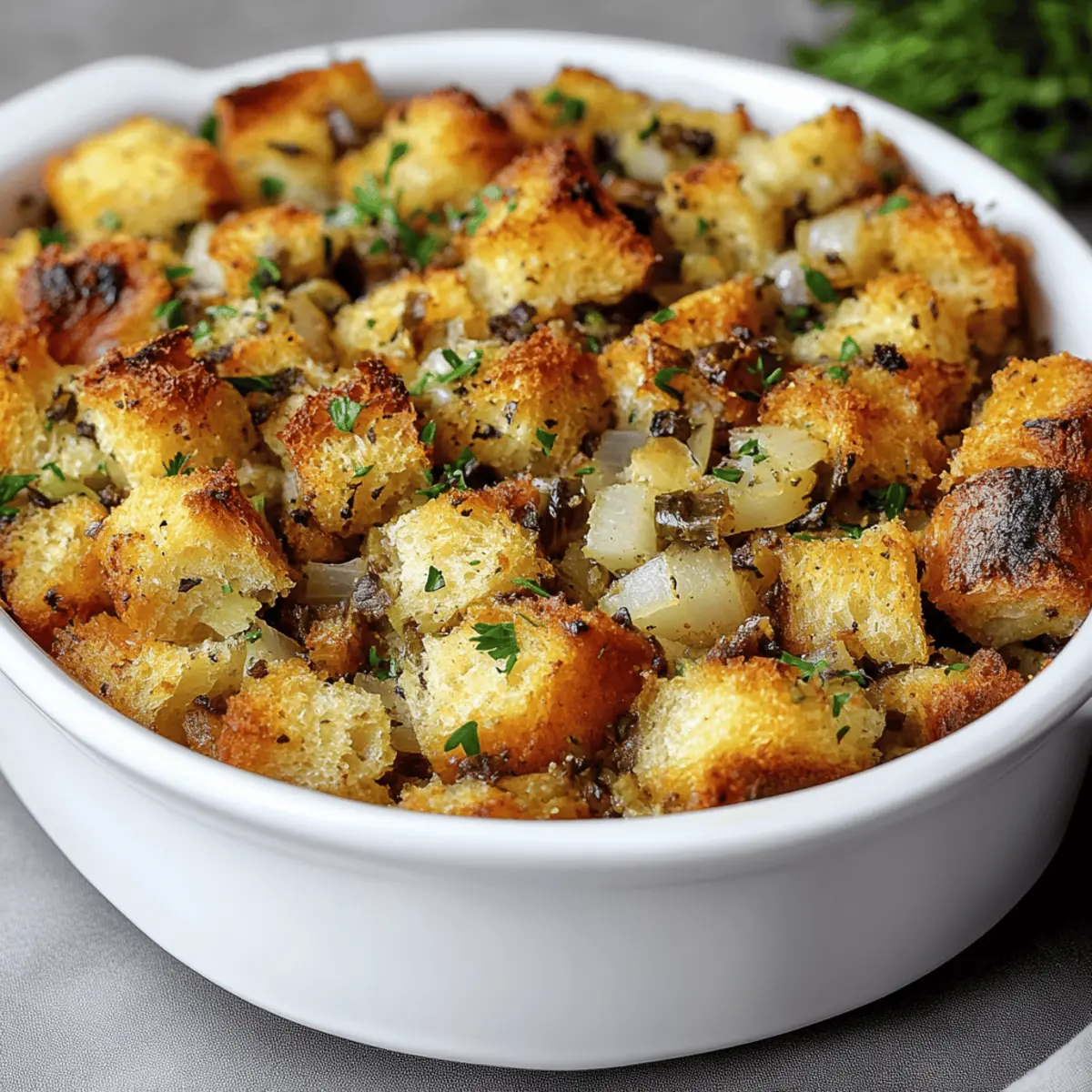
Why Is Homemade Stuffing Irresistible?
Comforting flavors: Each bite bursts with the warm, rich essence of sautéed onions and celery, making it the ultimate comfort food.
Fresh herbs: The blend of sage, marjoram, and parsley brings a robust aroma that elevates any meal.
Easy preparation: With straightforward, step-by-step instructions, even novice cooks can master this dish.
Crowd-pleaser: Perfect for holidays or casual dinners, this stuffing is sure to impress family and friends alike.
Versatile: Pair it with turkey, chicken, or enjoy it as a standalone dish—this stuffing seamlessly complements any entree.
Satisfying texture: The crispy top layer, combined with the soft, buttery interior, makes each mouthful a delicious experience. Take a look at how to make it from scratch for the perfect side dish!
Stuffing Ingredients
For the Base
• ¾ cup butter – A good quality butter adds richness and flavor that elevates the stuffing.
• 1 cup onions, diced – Sweet, sautéed onions bring a comforting sweetness to the dish.
• 1 cup celery, diced – Adds a crunchy texture and aromatic flavor that complements the other ingredients.
• 3 cups chicken broth – This moistens the stuffing and infuses it with savory flavor.
• 3 large eggs – Helps bind the ingredients together, ensuring a cohesive stuffing.
• 10 cups stale bread cubes – Using a hearty, bakery-style loaf gives the stuffing the perfect texture.
For the Seasoning
• 1 teaspoon salt – Highlights the flavors and balances the seasoning.
• ½ teaspoon pepper – Adds a subtle warmth that enhances the overall taste.
• 1 teaspoon poultry seasoning – A savory blend that perfectly complements the stuffing theme.
• 1 teaspoon marjoram – Brings a sweet, pine-like flavor that brightens the dish.
• 1 teaspoon sage – The classic herb for stuffing, providing an earthy note.
• 1 teaspoon parsley – Freshens the overall flavor profile with its bright notes.
For the Topping
• 2 tablespoons butter – These cubes of butter create a beautifully golden and crisp top layer as it bakes.
This Homemade Stuffing recipe is all about bringing warmth and heart to your table, leaving everyone craving more!
Step‑by‑Step Instructions for Homemade Stuffing
Step 1: Preheat and Prepare
Begin by preheating your oven to 350°F (175°C). While the oven is heating, generously butter a 9×9-inch baking dish, or opt for a 9×13-inch dish if you're doubling the recipe. This will ensure a beautifully crisp and golden edge to your delicious homemade stuffing.
Step 2: Sauté Vegetables
In a large skillet over medium heat, melt ¾ cup of butter. Once melted, add in 1 cup of diced onions and 1 cup of diced celery. Sauté these aromatic vegetables for 20 to 30 minutes, stirring occasionally until they are soft and translucent. The savory fragrance will start to fill the kitchen as they cook down.
Step 3: Mix in Seasonings
Remove the skillet from heat and stir in 1 teaspoon of salt, ½ teaspoon of pepper, 1 teaspoon of poultry seasoning, 1 teaspoon of marjoram, 1 teaspoon of sage, and 1 teaspoon of parsley. This blend of seasonings will elevate your stuffing with robust flavor. Mix well to ensure all the spices are evenly distributed throughout the softened vegetables.
Step 4: Combine Eggs and Broth
In a small bowl, whisk together 3 large eggs and 3 cups of chicken broth until fully blended. This mixture will not only help bind the stuffing but also bring moisture to the dish. Set this aside for later to allow the flavors to come together before adding it to the bread.
Step 5: Prepare Bread Mixture
In a large mixing bowl, add 10 cups of stale bread cubes. Once the sautéed vegetable mixture has cooled slightly, pour it over the bread. Gently stir using a spatula, allowing the bread to absorb all that buttery goodness of the homemade stuffing while enjoying the blend of textures.
Step 6: Incorporate Egg Mixture
Now add the previously prepared egg and broth mixture to the bread and vegetable combination. Toss everything together carefully until all the ingredients are evenly coated. The bread should feel moist but not soggy—a perfect texture for baking.
Step 7: Transfer to Baking Dish
Pour the entire stuffing mixture into your prepared baking dish. Spread it out evenly using a spatula so that it bakes uniformly. To enhance the top layer, dot with 2 tablespoons of butter cut into small cubes, ensuring a rich, golden finish.
Step 8: Bake Covered and Uncovered
Cover the dish with foil and place it in the preheated oven. Bake for 30 minutes, then uncover and continue baking for an additional 15 minutes. This dual baking method allows the stuffing to cook through while achieving a golden crust on top.
Step 9: Crisp the Top
For a crispy finish, turn on your broiler for 1 to 2 minutes at the end of baking. Keep a close eye on it, as it can brown quickly! After achieving a perfect golden color on top, remove the stuffing from the oven and let it cool slightly before serving.
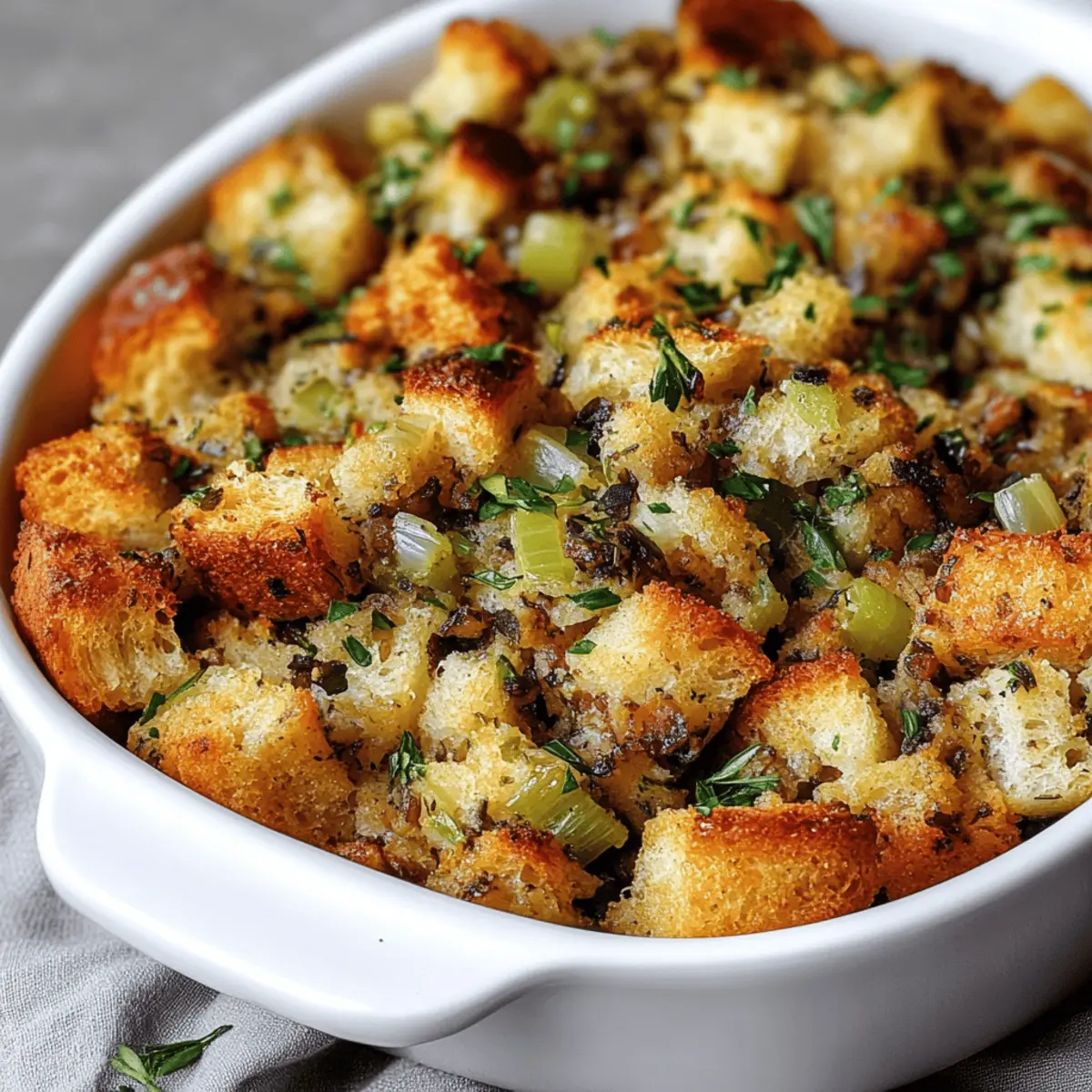
Make Ahead Options
These Homemade Stuffing options are perfect for busy cooks looking to save time during the holidays! You can prepare the vegetable mixture (onions, celery, and seasonings) up to 3 days in advance; simply let it cool, then refrigerate it in an airtight container. Additionally, you can mix the bread cubes and the egg-broth mixture a day ahead—just keep each component separate until you’re ready to bake to maintain their textures. When it's time to serve, combine everything in your buttered baking dish, dot with butter, and bake uncovered as directed for a comforting, crowd-pleasing dish that’s just as delicious as freshly made!
What to Serve with Homemade Stuffing
The perfect meal is just a side dish away, and these delightful pairings will create a comforting feast.
- Roast Turkey: A classic pairing, the savory flavors of roast turkey beautifully complement the richness of the homemade stuffing.
- Cranberry Sauce: Sweet and tart, cranberry sauce adds a refreshing contrast to the savory stuffing, balancing the flavors perfectly.
- Garlic Mashed Potatoes: Creamy and buttery, these mashed potatoes enhance the textures of the stuffing while providing a heavenly mouthfeel.
- Green Bean Almondine: Crisp green beans topped with toasted almonds offer a fresh crunch, lightening the meal with vibrant colors and flavors.
- Gravy: A rich, savory gravy pools over both the turkey and stuffing, tying the dish together with delicious moisture.
- Stuffed Acorn Squash: Roasted acorn squash filled with quinoa and cranberries brings a sweet and nutty complement to the stuffing's savory depth.
- Apple Cider: A glass of warm apple cider, spiced with cinnamon, adds a cozy touch to the table, echoing the warmth of the stuffed dish.
- Pumpkin Pie: Finish with a slice of classic pumpkin pie; its spices and sweetness create a lovely conclusion to your holiday feast!
These pairings will enhance your homemade stuffing experience, ensuring a meal that wraps everyone in warmth and nostalgia.
Stuffing Recipe Variations
Feel free to get creative with your stuffing and customize it to fit your family's taste and dietary needs!
- Gluten-Free: Substitute stale bread cubes with gluten-free bread or cornbread for a delicious gluten-free version.
- Vegetarian: Replace chicken broth with vegetable broth and omit the poultry seasoning for a fully vegetarian stuffing.
- Add Protein: Stir in cooked sausage or diced bacon to infuse your stuffing with hearty, savory flavors. The rich meatiness creates a delightful contrast with the herbs!
- Fruity Twist: Incorporate diced apples or dried cranberries for a hint of sweetness that balances the savory notes perfectly. You'll be amazed by this unexpected harmony!
- Nuts Galore: Add chopped walnuts or pecans to introduce a delightful crunch and nutty flavor that enhances every bite.
- Herbed Up: Experiment with different herbs like thyme or rosemary, which can offer unique notes and elevate the overall flavor profile.
- Spicy Kick: Toss in a pinch of red pepper flakes or diced jalapeños for a warm, spicy surprise that perks up your stuffing.
- Brothy Goodness: Instead of using chicken broth, try mushroom broth for an earthy flavor that's a perfect complement to the herbs in the stuffing.
With these mouthwatering variations, your homemade stuffing will never be boring! Feel free to explore and share your own combinations, like the ones you might find in my other beloved side dishes—just check out my Creamy Mashed Potatoes or Classic Green Bean Casserole for more inspiration!
Storage Tips for Stuffing
Fridge: Store any leftover stuffing in an airtight container for up to 3 days. Make sure it's completely cooled before sealing to avoid condensation.
Freezer: For longer storage, freeze stuffing in a freezer-safe container for up to 3 months. Thaw overnight in the fridge before reheating.
Reheating: To reheat, place the stuffing in a baking dish, cover with foil, and warm in a preheated oven at 350°F for about 20-25 minutes, or until heated through.
Room Temperature: Avoid leaving stuffing at room temperature for more than 2 hours to ensure food safety and quality.
Tips for the Best Stuffing
Choose Stale Bread: Use stale bread cubes for the best texture; fresh bread can become too soggy during baking.
Don't Rush Sautéing: Take your time sautéing the onions and celery; this step develops deep, savory flavors in your stuffing.
Mix Gently: When combining the bread and liquid, be gentle to avoid breaking the bread too much; you want nice, chunky pieces in your stuffing.
Test Seasoning: Before baking, taste the mixture and adjust seasonings as needed; this ensures your stuffing is perfectly seasoned.
Watch the Broil: Keep a close eye on your stuffing during the broil step; it can go from golden to burnt in just a minute!
Embrace these tips to elevate your homemade stuffing experience and delight your family and friends!

Homemade Stuffing Recipe FAQs
How do I choose the best bread for stuffing?
Absolutely! For the best texture in your homemade stuffing, opt for stale, hearty bakery-style bread like sourdough or French bread. Stale bread has less moisture, which allows it to absorb broth and flavors without becoming soggy. If your bread is fresh, simply cut it into cubes and let it sit out for a day or two, or toast it lightly in the oven to dry it out.
What’s the best way to store leftover stuffing?
Very! Store your leftover stuffing in an airtight container in the fridge for up to 3 days. It's essential to make sure it's cooled completely before sealing to prevent moisture buildup, which could lead to spoilage. If you don’t think you’ll finish it within that time frame, freezing is a great option!
Can I freeze stuffing? If so, how?
You bet! To freeze your homemade stuffing, first let it cool completely, then transfer it to a freezer-safe container or a resealable bag. Label the container with the date, and you can freeze it for up to 3 months. When you're ready to enjoy it again, thaw it overnight in the fridge. To reheat, place it in a baking dish, cover with foil, and warm in a preheated oven at 350°F for about 20-25 minutes until heated through.
What should I do if my stuffing is too dry after baking?
Uh-oh! If you find your stuffing is a bit dry, don't worry! You can sprinkle a little extra chicken broth over it before baking, or right before serving, to add moisture. Alternatively, if it’s already baked, adding a drizzle of melted butter or broth can help rejuvenate it. It should help bring back that delightful texture!
Is this stuffing recipe suitable for my dog?
Good question! This homemade stuffing contains ingredients like onions and certain seasonings that can be harmful to pets. It's best to avoid giving your dog any stuffing that includes those items. If you’d like to prepare a special stuffing for your furry friend, consider using plain, cooked turkey or chicken with some dog-friendly vegetables like carrots or green beans!
How can I ensure my stuffing is perfectly seasoned?
Very important! Taste before baking is key! As you mix the ingredients, take a small spoonful and give it a taste. You can always adjust the seasoning—feel free to add more salt or herbs according to your taste preferences. Just remember, flavors can mellow during baking, so don’t be afraid to be a little generous with those herbs and spices!
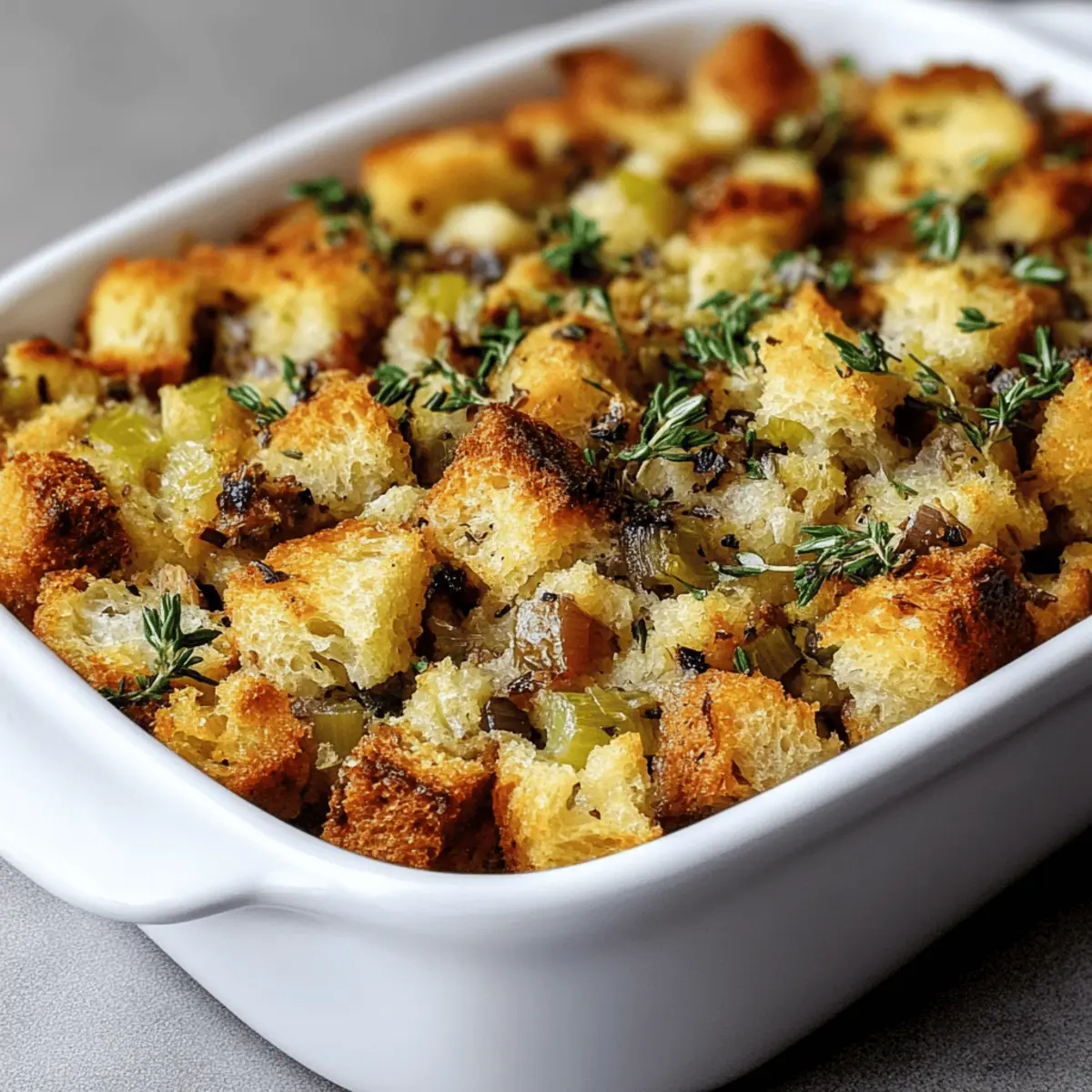
Savory Stuffing That Will Make Your Holidays Extra Special
Ingredients
Equipment
Method
- Preheat your oven to 350°F (175°C) and butter a 9×9-inch baking dish, or opt for a 9×13-inch dish if you're doubling the recipe.
- In a large skillet over medium heat, melt ¾ cup of butter and add in 1 cup of diced onions and 1 cup of diced celery. Sauté for 20 to 30 minutes until soft and translucent.
- Remove the skillet from heat and stir in 1 teaspoon of salt, ½ teaspoon of pepper, 1 teaspoon of poultry seasoning, 1 teaspoon of marjoram, 1 teaspoon of sage, and 1 teaspoon of parsley.
- In a small bowl, whisk together 3 large eggs and 3 cups of chicken broth until fully blended. Set aside.
- In a large mixing bowl, add 10 cups of stale bread cubes. Pour the sautéed vegetable mixture over the bread and stir gently.
- Add the egg and broth mixture to the bread and vegetable combination. Toss until all ingredients are evenly coated.
- Pour the stuffing mixture into your prepared baking dish and spread it out evenly. Dot with 2 tablespoons of butter.
- Cover with foil and bake for 30 minutes, then uncover and bake for an additional 15 minutes.
- For a crispy finish, broil for 1 to 2 minutes, being careful not to burn.


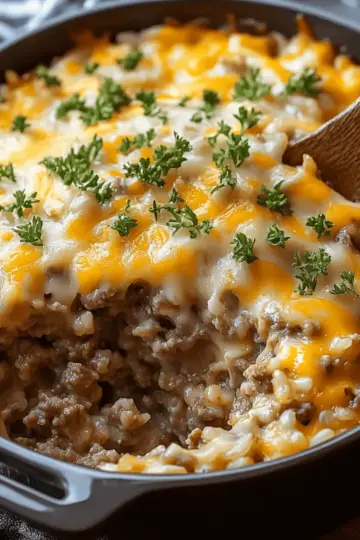
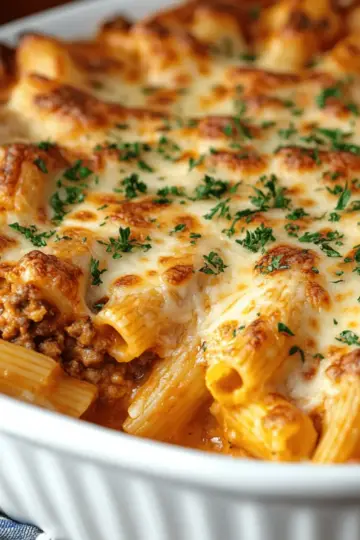

Leave a Reply